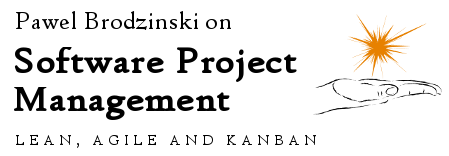There’s a fundamental flaw in how we manage project portfolios. What typically happens is we focus on estimated cost of work and expected profit. After all these are parameters that decide whether a project is successful or not.
Estimated Cost and Expected Profit
There’s whole ongoing discussion on how to estimate, when estimates give us value and whether we should estimate at all. A bottom line is that getting estimates right is extremely hard.
A problem is that, even if we got our estimate right, the scope of a project will change anyway thus it will affect the original estimate. Few companies would bother to change the estimates but even for these few there already are some numbers in contracts and budgets that won’t change anyway.
It seems that one of the critical numbers we use to make decisions about our portfolios is vague.
By the way if we are in the context of fixed price contracts it automatically means that the other number—expected profit—has changed as well.
It’s not a rare case to see these values changing drastically. I can come up with examples from my experience when, because of misestimate or increasing costs instead of margin of 30-60% the project ended up costing a few times more than the revenue a company got for doing it. Not only wasn’t it even close to breakeven but the company paid a huge toll in terms of both direct costs and lost opportunities.
A partial solution to that is transiting to time and material contracts where the revenue is a derivative of effort invested in building a project. While that definitely helps to avoid direct loses it doesn’t really fix the variables. The time span of a project can be changed thus the absolute numbers will be altered.
What You See Is All There Is
Even if we potentially could get our number right it wouldn’t really help. A root cause for that is a concept described by Dan Kahneman: What You See Is All There Is (WYSIATI). Human brain doesn’t look for data points other than those readily available. In other words if we define existing and potential projects from a perspective of estimated cost and expected profit these will be the main, or even the only, inputs for decisions on starting new projects.
This has very sad consequences. In neither case we assume that in normal circumstances we will be working on unprofitable ventures. If we are in the world of fixed price contracts the final price will directly depend on an initial estimate.
We’ve already discovered one painful dependency between an estimate and a profit. While costs are changing the contract terms remain the same affecting profits. It is even worse than that. The price was calculated based on the same estimate most likely by multiplying it be a factor of expected margin. Unfortunately humans are crappy at estimation.
And don’t even get me started about all those dysfunctional situations when there’s a pressure to reduce an estimate because a client has a limited budget or something.
In either case, a picture of all the potential projects will be rosy. We won’t allow it to be different than that. We will tweak the numbers back and forth until they fit the rosiness of the picture.
The ultimate issue of this is that, because WYSIATI kicks in, our decisions about starting new projects will be overly optimistic and heavily biased toward perceived attractiveness of our endeavors. A simple fact that it has very little to do with the real outcomes of projects or our appalling track record with assessing attractiveness doesn’t change it. What you see is all there is.
Overcommitment and Multitasking
The end result of this bias is easy to predict. Since all things seem to be overly attractive we tend to start too many projects. Eventually, and pretty soon, we are overcommitted beyond the point where we can comfortably finish everything before agreed deadlines.
Even in the cases when a flash of sanity keeps us from jumping off the cliff and stop one step before there’s usually not nearly enough slack in the system to account for any emergency that would happen.
Of course there’s no plan whatsoever in case our initial estimate was wrong and we need more effort to finish a project, because we’ve proven to be perfect estimators in the past and never got anything wrong. Oh, wait…
What does happen next? Expediting of course. When heroics within a team is not enough we pull people from other teams just like there was no tomorrow and they weren’t doing meaningful work on other committed projects. Anyone wants to guess what happens in the projects that we cannibalized to save the other one?
More of the same vicious cycle.
Not only such work is ultimately inefficient but it also hits sustainability of the business as it damages relationships with clients.
Informed Decisions
To reverse that cycle we need to go to the first place, the point of commitment, and change the drivers that influence our decisions. Bearing WYSIATI in mind, what we need is access to meaningful bits of information.
We need to know how our current commitments affect our capabilities over time. In other words we want to know which teams are working on which projects. Not only now but also in reasonable future. What reasonable future means will of course vary depending on a context.
How would a new project fit available capabilities? Do we have people with the right skills and knowledge available? When are they available? How much slack do we need to be able to respond to uncertainty in existing endeavors?
We need to know, at least roughly, what is Cost of Delay for new projects. Is it possible to delay start of this project for a month? How about longer? What kind of costs, or lost future gains will it incur?
What is value of a new endeavor? Is it money that earn only? How about long-term relationships with a client or bringing more financial safety thanks to a steady flow of work?
By the way, when we are talking about value, it is crucial to remember that value for our organization doesn’t equal value for a client. Of course, the more aligned these two are the better, but it’s almost never an ideal fit.
What are the risks attached to a project? How sure can we be about all the assumptions we make?
These are all crucial factors that we should be taking into consideration when making a decisions about starting any new project. If we don’t have them at hand, as a result of WYSIATI, they will be ignored and we’ll be back to our rosy, overly optimistic and utterly harmful view of portfolio.
Bad news is that to do better we need pretty broad understanding of the mechanisms that drive us sideways. Good news is that once we know that the change isn’t that painful. Focusing on different kind of data will alter decision making process on a portfolio level.


 Subscribe RSS feed
Subscribe RSS feed Follow on Twitter
Follow on Twitter Subscribe by email
Subscribe by email



0 comments… add one